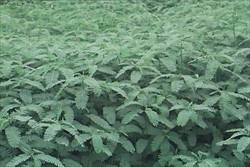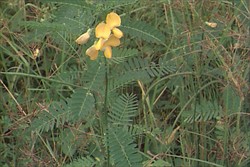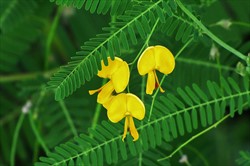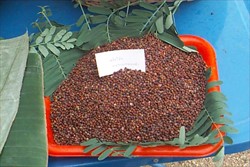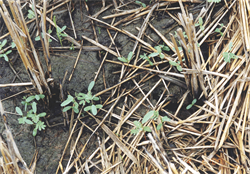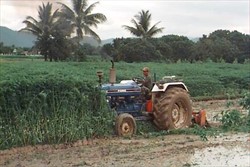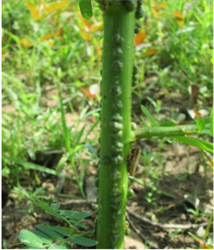Sesbania rostrata
Tropical Forages
Sesbania rostrata Bremek. & Oberm.
None cited in GRIN.
Family: Fabaceae (alt. Leguminosae) subfamily: Faboideae tribe: Sesbanieae.
Erect, suffrutescent annual or short-lived perennial, 1‒3 m tall, with pithy sparsely pilose stems to 15 mm thick (more mature stems glabrescent); root primordia protruding up to 3 mm in 3 or 4 vertical rows up the stem. Leaves paripinnate (4.5‒) 7‒25 cm long; stipules linear-lanceolate, 5‒10 mm long, reflexed, pilose, persistent; petiole 3‒8 mm long, pilose; rachis up to 19 cm long, sparsely pilose; stipels present at most petiolules; pinnae opposite or nearly so, in (6‒) 12‒24 (‒27) pairs, oblong, 0.9‒3.5 cm × 2‒10 mm, the basal pair usually smaller than the others, apex rounded to obtuse to slightly emarginate, margins entire, glabrous above, usually sparsely pilose on margins and midrib beneath. Racemes axillary, (1‒) 3‒12 (‒15) -flowered; rachis pilose 1‒6 cm long (including peduncle 4‒15 mm); bracts and bracteoles linear-lanceolate, pilose; pedicels pedicel 4‒15 (‒19) mm long, sparsely pilose. Calyx sparsely pilose; receptacle 1 mm, calyx tube 4.5 mm long; teeth markedly acuminate, with narrow sometimes almost filiform tips 1‒2 mm long. Corolla yellow or orange; suborbicular, 12‒16 (‒18) mm × 11‒14 (‒15) mm; wings 13‒17 mm × 3.5‒5 mm, yellow, a small triangular tooth and the upper margin of the basal half of the blade together characteristically inrolled; keel 12‒17 mm × 6.5‒9 mm, yellow to greenish, basal tooth short, triangular, slightly upward-pointing with small pocket below it on inside of the blade; filament sheath 11‒13 mm, free parts 4‒6 mm, anthers 1 mm long. Ovary glabrous; style glabrous, 5‒6 mm long. Pod, curved 15‒22 cm long, including a slender beak of 1.5‒3.5 cm; septa 4.5‒5.5 mm apart. Seeds sub-cylindrical (3‒3.5) × (2.5‒3) × (2‒2.5), light to dark brown, minutely dotted with violet; hilum 0.5 mm long; 50,000 ‒70,000 seeds per kg.
Asia: turi mini (Indonesia); girkhe dhaichaa (Nepal); sano african (Thailand)
English: rostrate sesbania, sesbania
India: jantar, manila agathi; dhaincha (mostly applied to Sesbania bispinosa (Jacq.) W. Wight var. bispinosa)
Spanish: rostrado sesbania
Native:
Africa: Botswana; Central African Republic; Chad; Democratic Republic of the Congo; Ethiopia (s.w.); Mali; Malawi; Mauritania; Namibia; Niger; Nigeria (n.); Senegal; Sudan; Tanzania; Zimbabwe
Indian Ocean: Madagascar
Cultivated/naturalized:
Asia, South: Bangladesh; India; Myanmar; Nepal; Sri Lanka
Asia, South East: Indonesia; Philippines; Thailand
Forage
While S. rostrata is primarily used as green manure, it can also be fed to small ruminants, although there are doubts about its palatability to cattle and carabao.
Environment
S. rostrata is used as green manure between rice crops, or as an intercrop in transplanted rice. As a green manure, it is allowed to grow for 55‒60 days from a mid-May sowing (N hemisphere), before incorporation into the soil, and rice is transplanted 7‒10 days after incorporation of S. rostrata. Improvement in rice yield is equivalent to an application of 160‒200 kg/ha N. Growing soybean plants are often infested with various species of stink bug (Hemiptera, Pentatomidae) that can cause severe damage to young seeds ripening in the pod. Of trap crop were tested, including long bean, cowpea and pigeon pea, S. rostrata was one of the most effective.
Other
Vigorous stands suppress weeds, reducing the need for herbicides in rice systems. In some countries leaves are eaten by people, and stems can be used for firewood.
Soil requirements
Occurs naturally on periodically flooded or waterlogged, deep clayey alluvial soils. Adapted to poorly drained and flooded soils of at least moderate fertility, with pH 5.5 to slightly alkaline. Can grow in more acid conditions (down to pH 4.3), but N fixation is less efficient. Establishment on heavy clays can be difficult. Tolerant of low to moderate salinity. Seed germination percentage and seedling growth decline sequentially as salinity rises to 16 dS/m.
Moisture
Occurs naturally in areas of 600‒1,000 mm rainfall, but mostly in wet and muddy places on flood plains, in seasonal swamps and around the margins of more permanent swamps into quite dry country. Mature plants can grow in water 30 cm or more deep. It can also be grown on freely drained, moist soil in cultivation.
Temperature
Primarily a tropical plant, occurring between about 18º N and S, and from sea level to 1,600 m asl. It grows best at temperatures above 25 ºC.
Light
No data available, but probably not shade tolerant.
Reproductive development
S. rostrata is a short-day plant with a critical photoperiod of 12‒12.5 hours. This limits its use as a green manure since rapid vegetative growth is restricted to that part of the year with increasing daylengths. If grown in the short-day period, it flowers early resulting in lesser vegetative growth and lower nitrogen fixation. A later flowering type has been bred (see 'Cultivars').
Defoliation
Plants ratoon following severe cut back, but should be allowed 6‒8 weeks to recover before cutting again.
Fire
No data available. Not normally grown in fire-prone situations.
Establishment
S. rostrata can be propagated from cutting or from seed, growing slowly in the first 30 days, but sufficiently by 50‒60 days to be incorporated. Plants established from cutting grow 2‒2.5 times faster in the first 42 days than seeded plants. Cuttings should be 30 cm long (15 cm is adequate but plants do not develop as quickly) at a planting density of 50‒100/m². High levels of hard-seededness require scarification to achieve rapid germination. This can be achieved by various means:
- physical abrasion of the seedcoat
- hot water at 80 °C for about 5 minutes or 100 °C for 3 seconds
- concentrated sulphuric acid for 15 minutes, followed by thorough washing with fresh water, and sowing immediately
Inoculation of seed or cuttings in wet areas with Azorhizobium caulinodans ORS571 is necessary to achieve high levels of N fixation. Both root and stem nodules form as a result of infection by Azorhizobium caulinodans ORS 571 (= ATCC 43989 = CCUG 26647 = DSM 5975 = IFO (now NBRC) 14845 = LMG 6465) and fix atmospheric nitrogen. The root nodules appear to form by root hair infection in a process intermediate between indeterminate and determinate types. Stem nodules occur in rows at the sites of adventitious root primordia, the bacteria entering via fissures caused by erupting primordia. Unlike the root nodules, the aeschynomenoid stem nodules contain functioning chloroplasts and are therefore capable of photosynthesis. Another rhizobial species, Sinorhizobium teranga is found in root nodules.
Seed is normally sown at 20‒40 kg/ha between February and May (N hemisphere) for green manure and about 8 kg/ha from March to May for a seed crop. If grown as an intercrop with rice, planting should be delayed 30 days to avoid excessive competition with the rice.
Fertilizer
S. rostrata responds to lime in strongly acidic soils, and phosphorus (about 20 kg/ha P) in low fertility soils. If inoculated with the correct strain of Azorhizobium caulinodans, it can fix large amounts of nitrogen (50‒200 (‒300) kg/ha) often in a matter of only 6‒8 weeks.
Compatibility (with other species)
If established as an intercrop in rice at the same time as the rice, it out-competes the crop, but is suppressed by the rice if sown 30‒60 days after the crop.
Companion species
Grasses: rice (Oryza sativa), maize (Zea mays).
Legumes: rice bean (Vigna umbellata), jointvetch (Aeschynomene afraspera).
Pests and diseases
Blister beetles (Coleoptera, Meloidae) attack S. rostrata when it is in flower, eating leaves and growing tips. Green vegetable bug (Nezara viridula) reduces yields in seed crops through sucking developing pods. Adults feed on the crop, but it is not suitable for nymphal development, making it an ideal trap crop for this insect. Pod borers also are damaging to seed crops. A leaf roller, possibly lucerne leaf roller (Merophyas divulsana Lepidoptera: Tortricidae) has damaged growing tips in stands in the subtropics.
S. rostrata is susceptible to damping off caused by Pythium and Rhizoctonia, a Cercospora leafspot, and leaf mosaic virus. Rootknot nematodes (Meloidogyne spp.) are damaging in better drained soils. However, it can acts as a plant trap for the nematodes, Hirschmanniella oryzae and H. spinicaudata, that damage rice crops.
Ability to spread
S. rostrata is limited to small wet areas in its native environment. No record of spread elsewhere.
Weed potential
No record of weediness, possibly because it is usually turned under before flowering when used as a green manure.
Nutritive value
Foliar CP levels are usually of the order of 30%, stems 7‒12%, and whole plant 24%. P levels have been measured at 0.2‒0.3% in both leaf and stem, and Ca levels at 1‒2% in leaves and about 0.7% in stems. NDF, ADF, hemicellulose, cellulose and lignin levels of 54.6, 39.2, 15.4, 30.5 and 8.7%, respectively, and IVDMD of 55.6% have been reported.
Palatability/acceptability
Readily eaten by sheep and goats, sometimes by camels, but not relished by cattle and carabao.
Toxicity
No record of toxicity.
Dry matter
A good crop with 500,000 plants per hectare is capable of producing 3‒5 (‒7) t/ha DM in 55‒60 days.
Animal production
Goats (5 months, 9.0 kg live weight) fed S. rostrata leaves ate 259 g/d DM and gained 38 g/day. Leaf meal may also serve as a concentrate fed with poor quality feeds such as rice straw.
2n = 12. Germplasm collections are maintained at IRRI at Los Baños in the Philippines, and at IRD, Dakar, Senegal.
Seed can be produced when daylengths are shorter than 11 hours. During this period, it flowers in 30 to 35 days and bears seed 30 days later. Recommendations for time of sowing for seed crops vary from March to May, to as late as an August sowing for a December harvest, in the northern hemisphere. A plant spacing of 45 × 20 cm is used, and nipping of terminal buds carried out 2 months after sowing to encourage branching and improve seed yield. Pods ripen over a long period, and are normally hand-harvested. Morning harvest is preferable to avoid pod-shattering and seed loss. Seed yields of 0.5‒2 t/ha have been achieved. Seed harvested during the rainy season is often of lower quality due to pod borer infestation.
No information available specifically for S. rostrata. However, the morphologically and agronomically similar weed species, S. cannabina, can be controlled with pyrithiobac-sodium, trifloxysulfuron sodium, atrazine, S-metolachlor, fluroxypyr and carfentrazone-ethyl.
- Tolerant of waterlogging.
- Fixes large amounts of nitrogen.
- Easily vegetatively propagated.
- Labour-intensive seed production.
- Unpalatable to cattle and carabao.
- Susceptibility to insect attack.
Becker, M., Diekmann, K.H., Ladha, J.K., De Datta, S.K. and Ottow, J.C.G. (1991) Effect of NPK on growth and nitrogen fixation of Sesbania rostrata as a green manure for lowland rice (Oryza sativa L.). Plant and Soil 132:149–158. doi.org/10.1007/BF00011021
Becker, M., Ladha, J.K. and Ottow, J.C.G. (1990) Growth and N2-fixation of two stem-nodulating legumes and their effect as green manure on lowland rice. Soil Biology and Biochemistry 22:1109–1119. doi.org/10.1016/0038-0717(90)90037-Z
Becker, M., Ladha, J.K., Watanebe, I. and Ottow, J.C.G. (1988) Seeding vs. vegetative propagations of the stem-nodulating green manure Sesbania rostrata. Biology and Fertility of Soils 6:279–181. doi.org/10.1007/BF00261012
Del Barrio, A.N., Roxas, D.B., Lapitan, R.M, Momongan, V.G. and Furoc, R.E. (1988) Composition and in vitro digestibility of different sesbania varieties. Philippine Journal of Veterinary and Animal Science 19:87–94.
Dreyfus, B., Rinaudo, G. and Dommergues, Y. (1985) Observations on the use of Sesbania rostrata as green manure in paddy fields. MIRCEN Journal of Applied Microbiology and Biotechnology 1:111–122. doi.org/10.1007/BF01742577
du Puy, D.J., Labat, J.N., Rabevohitra, R., Villiers, J.F., Bosser, J. and Moat, J. (2002) The Leguminosae of Madagascar. Royal Botanic Gardens, Kew, Richmond, UK.
Evans, D.O., and Rotar, P.P. (1987) Productivity of Sesbania species. Tropical Agriculture (Trinidad) 64:193–200. bit.ly/2Jqh27J
Giller, K.E. (2001) Nitrogen fixation in tropical cropping systems. CABI Publishing, Wallingford, Oxon, UK. doi.org/10.1079/9780851994178.0000
Gillett, J.B. (1963) Sesbania in Africa (excluding Madagascar) and southern Arabia. Kew Bulletin 17:91–159. doi.org/10.2307/4118710
Gillett, J.B., Polhill, R.M. and Verdcourt, B. (1971) Leguminosae (Part 3) Subfamily Papilionoideae. In: Milne-Redhead, E. and Polhill, R.M. (eds) Flora of Tropical East Africa. Crown Agents for Overseas Governments and Administrations, London, UK. p. 313–314.
Herrera, W.T., Garrity, D.F. and Vejpas, C. (1996) Management of Sesbania rostrata green manure crops grown prior to rainfed lowland rice on sandy soils. Field Crops Research 49:259–268. doi.org/10.1016/S0378-4290(96)01003-9
Ikeda, K., Kariya, Y., Takano, T., Enishi, O., Shijimaya, K. and Murai, M. (1997) Effect of sesbania silages (Sesbania cannabina Pers. and Sesbania rostrata) on the body weight gain and blood characteristics in Holstein steers. Grassland Science 42:353–359.
Ipor, I.B. (1997) Sesbania rostrata Bremek. & Oberm. In: Faridah Hanum, I. and van der Maesen, L.J.G. (eds) Plant Resources of South-East Asia No. 11. Auxiliary Plants. Backhuys Publishers, Leiden, the Netherlands. p. 240‒242. edepot.wur.nl/411331
Ndoye, I., de Billy, F., Vasse, J., Dreyfus, B. and Truchet, G. (1994) Root nodulation of Sesbania rostrata. Journal of Bacteriology 176:1060–1068. doi.org/10.1128/jb.176.4.1060-1068.1994
Ndoye, I., Dreyfus, B. and Becker, M. (1997) Sesbania rostrata as green manure in lowland rice-farming systems of Casamance (Senegal). Tropical Agriculture (Trinidad) 73(3):234–237. bit.ly/3ayimkX
Olsson, J.E. and Rolfe, B.G. (1985) Stem and root nodulation of the tropical legume Sesbania rostrata by Rhizobium strains ORS-571 and WE7. Journal of Plant Physiology 121:199–210. doi.org/10.1016/S0176-1617(85)80054-7
Saud, H.M., Norizan, T. and Shamsuddin, Z.H. (1993) Influence of Azorhizobium inoculation and fertilizer treatment on nodulation and growth of Sesbania rostrata on three tropical soils. Proceedings of the 10th Australian Nitrogen Fixation Conference, Brisbane, Australia.
Shahjalal, M.and Topps, J.H. (2000) Feeding sesbania leaves as a sole feed on growth and nutrient utilization in goats. Asian-Australian Journal of Animal Science 13(4):487–489. doi.org/10.5713/ajas.2000.487
Visperas R M, Furoc, R.E., Morris, R.A., Vergara, B.S. and Patena, G. (1987) Flowering response of Sesbania rostrata to photoperiod. Philippine Journal of Crop Science 12:147–149.
Whitbread, A.M., Chanphengsay, M., Linquist, B., Sengxua, P., Blair, G.J., Vongsouthi, S. and Phengsounanna, V. (1999) Sesbania rostrata as a green manure and phosphorus management for lowland rice production in Lao PDR. In: Whitbread, A.M. and Blair, G.J. (eds) Integrated Nutrient Management in Farming Systems in Southeast Asia and Australia. Proceedings of an International Workshop held at the National Agricultural Research Centre, Vientiane, Laos, 21-22 April 1999. p. 28–36.
'Jantar Magic' Released in India. Origin uncertain. Probably introduced to India in the 1980s from IRRI in the Philippines. The "standard" or common variety.
'Trombay' (TSR-1) Released in India. A late flowering irradiation-induced mutant. It remains vegetative for up to 60 days after the date of sowing, even in winter. This extends the period that the species can be used effectively as a green manure.
None selected.
